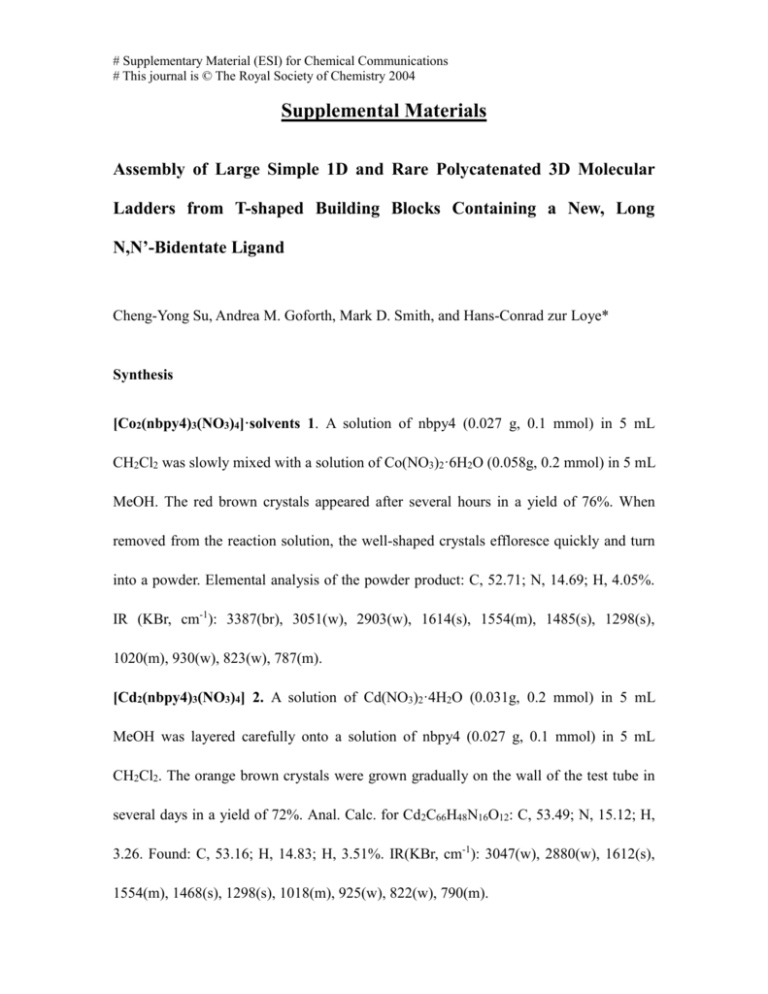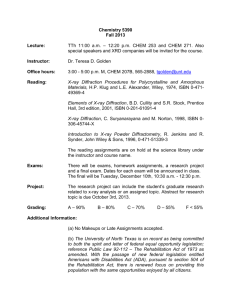Synthesis and characterization details
advertisement

# Supplementary Material (ESI) for Chemical Communications # This journal is © The Royal Society of Chemistry 2004 Supplemental Materials Assembly of Large Simple 1D and Rare Polycatenated 3D Molecular Ladders from T-shaped Building Blocks Containing a New, Long N,N’-Bidentate Ligand Cheng-Yong Su, Andrea M. Goforth, Mark D. Smith, and Hans-Conrad zur Loye* Synthesis [Co2(nbpy4)3(NO3)4]·solvents 1. A solution of nbpy4 (0.027 g, 0.1 mmol) in 5 mL CH2Cl2 was slowly mixed with a solution of Co(NO3)2·6H2O (0.058g, 0.2 mmol) in 5 mL MeOH. The red brown crystals appeared after several hours in a yield of 76%. When removed from the reaction solution, the well-shaped crystals effloresce quickly and turn into a powder. Elemental analysis of the powder product: C, 52.71; N, 14.69; H, 4.05%. IR (KBr, cm-1): 3387(br), 3051(w), 2903(w), 1614(s), 1554(m), 1485(s), 1298(s), 1020(m), 930(w), 823(w), 787(m). [Cd2(nbpy4)3(NO3)4] 2. A solution of Cd(NO3)2·4H2O (0.031g, 0.2 mmol) in 5 mL MeOH was layered carefully onto a solution of nbpy4 (0.027 g, 0.1 mmol) in 5 mL CH2Cl2. The orange brown crystals were grown gradually on the wall of the test tube in several days in a yield of 72%. Anal. Calc. for Cd2C66H48N16O12: C, 53.49; N, 15.12; H, 3.26. Found: C, 53.16; H, 14.83; H, 3.51%. IR(KBr, cm-1): 3047(w), 2880(w), 1612(s), 1554(m), 1468(s), 1298(s), 1018(m), 925(w), 822(w), 790(m). # Supplementary Material (ESI) for Chemical Communications # This journal is © The Royal Society of Chemistry 2004 Characterization Elemental analysis (EA), IR, TGA, X-ray powder diffraction (XRD) as well as single crystal X-ray diffraction have been used to identify both compounds. Compound 2 is air stable. An EA measurement of 2 indicates a composition of [Cd2(nbpy4)3(NO3)4] which is consistent with the single crystal diffraction analysis result. There are no solvent molecules in the crystal lattice, which is also confirmed by the TGA measurement. The first weight loss in the TGA occurs between 330 and 360 ºC, accounting for about 35% of the total weight. A subsequent gradual weight loss was observed between 360 and 700 ºC. On the contrary, compound 1 effloresces quickly when removed from the reaction solution. The crystalline product loses its guest solvent molecules quickly, becoming a powder and precluding efforts to obtain a precise EA for the as-prepared crystals. EA results of the powder product indicate a composition The of [Co2(nbpy4)3(NO3)4](CH2Cl2)(CH3OH)(H2O)3, which just accounts for part of the solvent molecules determined from the electronic map of the single crystal X-ray diffraction experiment. However, the existence of MeOH or H2O solvent molecules in the crystal lattice can be confirmed by IR measurements. A broad absorption around 3380 cm-1 due to OH vibration is observed in the spectrum of 1 but not of 2. TGA measurement exhibits a continual weight loss before 160 ºC, evidently indicating that the solvent molecules escape from the crystal. The subsequent weight loss behavior of 1 is quite similar to that of 2, but the structure decomposes at about 280 ºC, much lower than # Supplementary Material (ESI) for Chemical Communications # This journal is © The Royal Society of Chemistry 2004 2. The bulk phase purity of each product was checked by XRD measurements. Compound 2 yields an XRD pattern that closely matches the pattern simulated using the single crystal structure data (see Figure S2). However, the XRD pattern obtained from the effloresced powder product of 1 significantly deviates from the simulated one as shown in Figure S1. This finding suggests that a phase transformation happens while the solvent molecules escape from the crystal lattice. Therefore, it is impossible to determine the bulk product purity of 1 by XRD measurements, although the uniform appearance of all the crystals in solution indicates the presence of one single phase. Furthermore, powder X-ray diffraction has been used to investigate the possibility of reciprocal formation of the two types of structural topology from both of the metals. The rapid crystallization of the Cd compound results in an XRD pattern different from that of the Cd compound obtained by layering method (2), indicating formation of a new structure different from 2. Single crystal diffraction analysis was unsuccessful because of the poor quality of the crystals obtained by this rapid crystallization method. On the other hand, crystals obtained by the layering method with Co2+ gave a new structure with the cell parameters different from those of 1: space group P-1, a = 10.4616, b = 13.4800, c = 15.7288 Å, = 93.441 = 90.381, = 112.168º. However, the structure topology remains the same, meaning that the non-interpenetrated ladder is formed even when the product is grown slowly. These findings indicate that the rate of the crystallization will affect the packing of the product, especially for the non-interpenetrated structures owing to the existence of # Supplementary Material (ESI) for Chemical Communications # This journal is © The Royal Society of Chemistry 2004 large amounts of solvent molecules, but the structural topology may be a function of the identity of the metal centers. Both aspects are associated with a complicated combination of kinetic and thermodynamic factors that ultimately control the formation of the different structures. # Supplementary Material (ESI) for Chemical Communications # This journal is © The Royal Society of Chemistry 2004 Fig. S1. Powder X-ray pattern of 1 and simulation based on the unit cell obtained from the single crystal analyses. # Supplementary Material (ESI) for Chemical Communications # This journal is © The Royal Society of Chemistry 2004 # Supplementary Material (ESI) for Chemical Communications # This journal is © The Royal Society of Chemistry 2004 Fig. S2. Powder X-ray pattern of 2 and simulation based on the unit cell obtained from the single crystal analyses.







